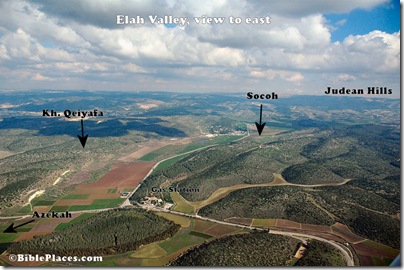I’m in the midst of compiling my “Top Five” list of archaeological discoveries of the year, and since Khirbet Qeiyafa stands a chance at making the top of the list, I thought it might be appropriate to share a recent “introduction” to the site that was included in the latest BiblePlaces Newsletter. This may be especially helpful to those who have not had the time to read some of the lengthy posts here.
Defining terms: Khirbet is a word with a meaning similar to “tell.” Whereas a tell has many layers, a khirbet consists of one or two, meaning that people only lived there in one or two periods in ancient times. Khirbet is often translated “ruin,” as opposed to a tell, which is translated as “mound.”
Qeiyafa is the name the locals gave to this particular ruin. Sometimes the modern names preserve the ancient name (for instance, Beisan was the Arabic name of biblical Beth Shean).
Where is it?: Kh. Qeiyafa is located in the western foothills (Shephelah) of the Judean hill country. More specifically, it sits on the northern side of the Elah Valley.
Elah Valley, that sounds familiar: Yes, that’s because when David fought Goliath, the two armies were situated on hills on opposite sides of the Elah Valley (1 Sam 17:2-3).

David and Goliath?: That’s where this whole story gets real interesting.
Tell me more: After two seasons of excavating, the ruins at Kh. Qeiyafa date to approximately 1000 B.C. According to the biblical chronology, David became king over Judah in about 1000 B.C.
Too bad they didn’t find an inscription: Actually, they did! It may be the earliest Hebrew inscription. It is quite difficult to read, which is why a translation has not yet been published.
Is Qeiyafa in the Bible?: Maybe. The excavator once suggested that the site was Azekah (1 Sam 17:1). Now he has proposed that it is Shaaraim (1 Sam 17:52). Another scholar has identified the site as Gob (2 Sam 21:18-19). I have argued that it may be Ephes-dammim, where the Philistine army was camped when they fought David (1 Sam 17:1).
What’s the bottom line:
1) This is an important site from the time of David.
2) Critical scholarship that has tended to minimize the importance of the Israelites during this time may need to revise their conclusions.
3) The inscribed potsherd is likely to be a big story when it is translated.
4) Continued excavations will likely reveal more in future years.
Where can I find more?: You can google Qeiyafa, go straight to the excavation’s website (#1 and #2), read my analysis of why the site may be Ephes-dammim, and why I don’t think it is Shaaraim or Gob. Other posts I have written (or will write) may be found here.
One thought on “Khirbet Qeiyafa: A Primer”
Just a quick note: A “khirbeh” is a ruin. A “tel” is an artificial mound built upon layers of destroyed earlier settlements. Their shared similarity comes from being distinct sites for archaeological excavation.
all the best,
David Willner
Foundation Stone